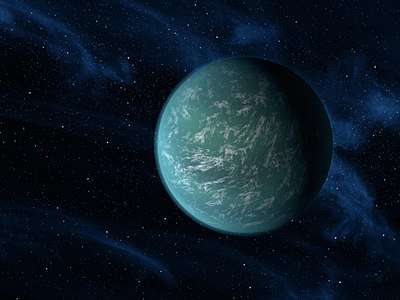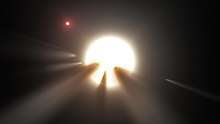LkCa 15 b
LkCa 15 b is a candidate protoplanetary object in orbit around LkCa 15, a star in the Taurus-Auriga Star Forming Region. It was discovered by direct imaging techniques using the Keck II telescope in 2011 by Adam Kraus and Michael Ireland.[1] A 2015 study of observations from the Magellan Telescopes and the Large Binocular Telescope argued that the planet is forming through accretion.[2] It is the first observed exoplanet seen in the process of active accretion.[3]
 LkCa 15 protoplanetary Disk
LkCa 15 protoplanetary Disk
| Discovery | |
|---|---|
| Discovered by | Kraus and Ireland[1] |
| Discovery site | Keck II |
| Discovery date | 2011 |
| Direct imaging | |
| Orbital characteristics | |
| 15.7 ± 2.1 AU (2.35×109 ± 310,000,000 km)[1] | |
| Star | LkCa 15 |
References
- Kraus, Adam L.; Ireland, Michael J. (2011). "LkCa 15: A Young Exoplanet Caught at Formation?". The Astrophysical Journal. 745 (1): 5. arXiv:1110.3808. Bibcode:2012ApJ...745....5K. doi:10.1088/0004-637X/745/1/5.
- Sallum, S.; Follette, K. B.; Eisner, J. A.; Close, L. M.; Hinz, P.; Kratter, K.; Males, J.; Skemer, A.; Macintosh, B.; Tuthill, P.; Bailey, V.; Defrère, D.; Morzinski, K.; Rodigas, T.; Spalding, E.; Vaz, A.; Weinberger, A. J. (2015). "Accreting protoplanets in the LkCa 15 transition disk". Nature. 527 (7578): 342–344. arXiv:1511.07456. Bibcode:2015Natur.527..342S. doi:10.1038/nature15761. ISSN 0028-0836. PMID 26581290.
- Irene Klotz (18 November 2015). "Astronomers see planet still growing in its stellar womb". Reuters. News Daily. Archived from the original on 19 November 2015. Retrieved 20 November 2015.
This article is issued from Wikipedia. The text is licensed under Creative Commons - Attribution - Sharealike. Additional terms may apply for the media files.


.jpg)


